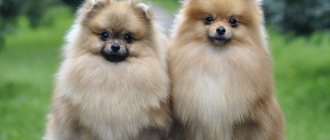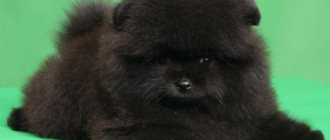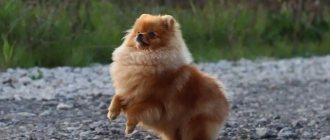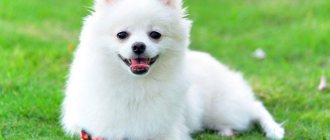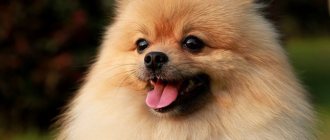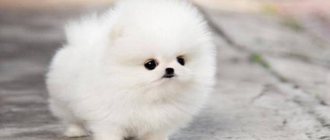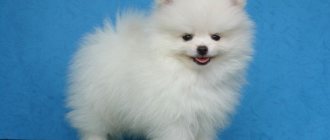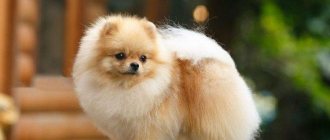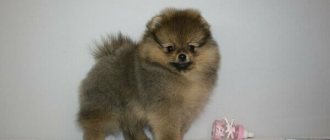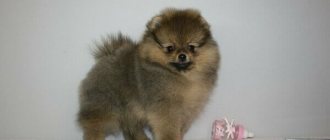Characteristics of the Pomeranian Dwarf Spitz breed
| Name | Meaning |
| Country of origin | Germany |
| Purpose | companion |
| Temperament | active |
| Constitution | miniature Pomeranian Spitz and characteristics of external qualities look impressive |
| Frame | strong, dry, muscular |
| Height | the height at the withers should be equal to the length of the body, namely 18–22 cm |
| Head | small with a pointed nose, the lobe of which is black or brown |
| Muzzle | slightly narrow, elongated at the “chanterelles” and slightly flattened at the “cubs” |
| Eyes | oval, almond-shaped, set obliquely |
| Teeth | number 42, scissor bite: upper teeth overlap lower teeth |
| Ears | triangular, erect, set high with sharp ends |
| Neck | solid medium length |
| Tail | short, set high, raised, rounded, lying on the back, folded into a ring |
| Paws | strong, straight, dark pads and nails, color exceptions may occur in cream, brown and red adult dogs |
| Movements | swift, springy |
| Wool | long guard with dense undercoat |
| Color | from pure white to black |
Basic colors
- White. The white dwarf orange should have a snow-white color. No extraneous shades in the form of darkening or yellowing of the coat are allowed.
- Black. A black Spitz should be pure black, with no brown, gray or reddish tints.
- Black and Tan . Jet-black base coat color, complemented by fawn or red markings located above the eyes, on the muzzle, ears, neck, chest, limbs and on the inside of the tail.
- Brown . Can be any of the brownish shades.
- Soboliny . The outer coat is zonally gray in color, and the undercoat is grayish, orange or cream.
- Ginger . It comes in different brightness and intensity: from golden to bright reddish-red. Also, dogs of orange color often have lightening of the fur on the inside of the paws, on the tail and on the neck.
- Cream . It may appear almost red or be difficult to distinguish from white.
- Zonal gray . The guard fur is darkened around the eyes, eyebrows, ears and tail. The undercoat is silver-gray. Due to this, an interesting effect of gradation of fur shades is created, making the orange look like a small wolf.
- Two-color . The main color of the coat is white. There are small markings on it in one of the three colors allowed by the standard: black, reddish or brown.
All other color variations, including merle, blue, tri-color and brown and tan, should be considered breeding grounds..
Origin of the breed and appearance
The Pomeranian Miniature Spitz traces its origins to the German turf dog. The predecessors of Pomeranian dogs weighed up to 23 kg and reached up to 45 cm at the withers. Spitz received its name from the Pomeranian region in East Germany, where the breed supposedly began to be bred in the 18th century. Subsequently, we randomly came to small dogs. The systematic breeding of dwarf Pomeranians began in Great Britain in the 19th century under Queen Victoria. In Europe, the queen was given a small dog, Marco, who won the heart of the great ruler. The baby turned out to be so cute that Victoria ordered to begin selection and breed a miniature dog based on this breed. At the end of the 19th century, a dwarf dog appeared, but larger than its modern relatives. The miniature orange spitz was obtained later, only in the 50s of the 20th century.
All Pomeranian representatives are conventionally divided into three subspecies depending on their appearance.
Bear type dwarf Pomeranian
It got its name because the dwarf spitz looks like a small bear cub. The animal's muzzle is shorter than that of a typical representative of the breed, and resembles a bear's. A correct rounded haircut further emphasizes the baby’s resemblance to a bear.
Fox-type dwarf orange
In appearance, they are most similar to the classic German Spitz: an elongated “fox” muzzle, long legs. And less fluffiness than the “bear cubs”.
Mini Pomeranian toy type
Transitional conditional type between bear and fox types. The muzzle is not elongated, but not too flattened either. The short-haired plush appearance will not leave anyone indifferent. The unusual location of the eyes gives the subspecies a special charm: wide apart, they make the animal look like a child’s toy. A real smooth-haired cutie.
Description
The Pomeranian is one of the tiniest breeds in the world. They are true extroverts who boast a kind and affectionate nature. The doggies look like mini foxes. Spitz dogs are easy to train and make excellent watchdogs, as they are cautious and intelligent.
Character qualities and behavioral characteristics
Pomeranians are temperamental, friendly, love walks and active games. It is not advisable for people seeking a quiet pastime to get themselves an active, cheerful prankster, such as the Pomeranian active mini dog. He will require a lot of attention and will not let the owner get bored.
From their German Spitz ancestors, Pomeranian babies inherited their protective and watchdog qualities. In an apartment, they will bark as a sign that a stranger is approaching the door. Spitz are fearless, ready to rush at any offender, regardless of his size and appearance. While walking, you will have to be careful and avoid conflict situations with other dogs.
Despite the relatively friendly nature of Spitz dogs, one must be careful when interacting with dogs and children. The cute appearance of the Shorthaired Pomeranian can be deceiving. A proud and independent character can emerge at unexpected times. A small dog will defend the boundaries of its possessions and will not allow itself to be treated like a toy.
Diseases
From the description of the Spitz dog it is clear that this is a small animal, and therefore it will not have problems with bones and joints. However, furry animals have their own breed problems:
- dislocations and increased injuries;
- dwarfism, manifested not only in miniature size, but also bulging eyes, not overgrown fontanel, problems of the central nervous system;
- improper growth of teeth due to long milk roots;
- periodontal disease and tartar formation;
- dry eyes;
- characteristic cough due to stressful situations;
- genetic alopecia;
- epilepsy.
Despite this, the breed boasts endurance and strength of body. All of these problems are a consequence of miniature size and anatomical features, and not a predisposition to disease.
Positive and negative characteristics of a pet
Approximately the same number of minuses and pluses in the character of a nimble Pomeranian baby speaks of the adequacy and relative psychological stability of the breed.
Positive features:
- a faithful companion, ready to adapt to any habits of his owner;
- small size is convenient for keeping in an apartment and for traveling;
- an active, cheerful friend, playful and tireless;
- a brave, reliable guard with observation skills and excellent guard dog skills;
- finds contact with familiar children, behaves warily and distantly with strangers;
- neat.
Negative points:
- noisy, barks a lot,
- may show aggression towards other animals, dogs, strangers;
- impatient, restless;
- prone to certain types of diseases;
- you will have to pay attention to hair care, cutting, combing;
- prone to dominance, tries to manipulate the owner.
Without behavioral adjustments and basic training, a puppy can grow into a spoiled, selfish creature, constantly barking and attracting attention. Take the time to train your Mini and you will end up with a friendly, obedient Pomeranian dog.
Ancient roots
The appearance of the breed is quite ancient. Swiss turf dogs are recognized as their ancestors. In the 19th century, archaeologists discovered skeletons of domesticated-looking animals. They were found on the site of pile dwellings. The remains partly resembled those of a wolf.
When trying to recreate the appearance, scientists had a completely unexpected discovery. The found skeleton was clearly similar in structure to modern Spitz dogs.
Ancestors of modern Spitz-types
Color options
The variety of colors of Pomeranian dwarf Spitz dogs is explained by the variety of nurseries on different continents. There are many colors, not all of them are recognized by the Fédération Cynologique Internationale.
To avoid misunderstandings in determining the correct color of a Pomeranian, you should study the standard colors recognized in all countries. These are white, beige, brown, red and black. Spotted color also has its limitations. Black fawn and gray fawn Spitz dogs are allowed to participate in exhibitions. The white color should not have any spots or impurities at all. A two-color combination of different shades is included in the color standards, but a three-color color is not officially recognized. In the USA, blue, sable, brindle and merle colors are popular, which are not recognized by the FCI and Russian standards for the Pomeranian Dwarf Spitz breed.
Before purchasing a puppy, determine its purpose. A Spitz acquired for exhibition purposes and a companion for the soul require different approaches to choosing a color.
In Russia, several main colors of Pomeranian Spitz are in demand: beige, red, brown, white and black.
Beige dwarf spitz
The cream or beige color of the animal varies in shade and can only differ by half a tone from white. At the other extreme it can be dark beige, almost red or close to light brown.
Dwarf brown spitz
The brown range includes all shades of this color from light to dark chocolate. A special feature of representatives of this color is a brown nose, which is only allowed on brown Spitz. Intense rich chocolate color is valued more than light shades.
Pomeranian dwarf spitz white
The miniature Pomeranian received its main white color back in England under Queen Victoria. Animals of all other colors were bred from him. It’s simply a miracle that the snow-white color did not disappear in the selective pursuit of diversity of the breed and bringing it to micro sizes and has survived to this day in its pure form. The beautiful white Spitz has been popular since the time of Queen Victoria.
A distinctive feature of a dwarf Spitz (mini) dog is its white color without any admixture of other shades.
Breeding
It is considered to be a difficult breed to breed. This is associated with the small size of the animal. A girl gives birth to 1-3 puppies at a time.
You must bring together purebred individuals of the breeding class to obtain purebred offspring. The breed-class pet fully complies with the standard. They must also have the appropriate documents: passport and confirmed pedigree.
Introduce the individuals before mating. It is important that the girl is slightly larger than the boy. Make sure your animals have all required vaccinations.
Estrus in females lasts about 22 days and occurs in 2 stages. The most favorable time for mating is after 10-12 days from the beginning of menstruation.
Leave the couple in a separate, quiet room during mating.
The pregnancy of an individual lasts 58-64 days.
For the first three weeks, the bitch may not show any signs of pregnancy. The female may develop toxicosis in the next 10 days. After the 5th week, obvious signs of an interesting position should appear, such as a rounded tummy and swollen nipples.
A girl's temperature may fluctuate during the last week of pregnancy and she will become restless.
Ensure that a veterinarian is present during the birth, especially if it is your female’s first.
Newborn puppies weigh from 55 to 125 g.
All photos of Spitz puppies and adult dogs
Tray training
Raising a clean dog is not that difficult. A tray for the puppy is arranged in the play area or near it. Primary training is organized using a diaper. Observing a German puppy, you can notice when he begins to look for a place to relieve his natural needs. Place a diaper where he sits. As soon as the Spitz performs the desired action, he is praised (petted). The diaper can be rinsed (but not washed), dried and placed approximately where it was used for its intended purpose.
Subsequently, when the puppy confidently uses the diaper, it is transferred to the tray. This way the “toilet” area will be moved and fixed. The tray is kept clean.
During walks, the dog is encouraged to eliminate. Gradually this will become a habit and the tray will lose its relevance.
All zones are organized not only taking into account the wishes of the Pomeranian, but to a greater extent respecting the interests of the owners. If it is undesirable for a dog to enter certain premises, you should simply block access to them from the very beginning of keeping it in the family. Pomeranians quickly get used to restrictions and take them for granted.
Basics of maintenance and care
The decorative breed requires special maintenance conditions. Preparation should begin before purchasing a puppy. Decide in advance on a place for a miniature family member, select hygiene items.
Diet
When picking up a puppy from a breeder, you need to ask what he was fed. And for 2-3 weeks it is better to stick to the same diet, gradually transferring the baby to the food that he will eat in the future.
Miniature Spitz puppies should be fed 5-6 times a day, gradually increasing the time intervals between meals. By the age of one year, it is recommended to switch to two feedings a day. Strictly adhering to the diet,
An adult Pomeranian should receive all vitamins and minerals in full. The diet should include vegetables, protein products - meat and offal, cereals. Or switch your dog to fully balanced Premium food.
Vaccination schedule
When taking the puppy home, you need to ask the breeder about the vaccinations given. The first vaccination is carried out at two months of age. Next, you should be vaccinated according to an individual schedule developed by a veterinarian. Vaccinations against major diseases should be repeated annually: distemper, rabies, enteritis, infectious hepatitis.
Timely vaccination will keep your pet healthy and strengthen its immunity.
Predisposition to disease
Breeding a miniature dog and selection efforts led to a weakening of the animal's body. Decorative dwarf Spitz dogs are prone to eye diseases. Daily inspection of the eyes for tearing and timely care help cope with the problem.
The condition of your teeth can cause concern if you do not pay proper attention to cleaning them. Losing baby molars can sometimes cause problems for puppies. It won't hurt to get help from a veterinarian.
The jumping and restlessness of the dwarf Spitz leads to the risk of joint injury.
Walks
It is advisable to take your pet outside 3-4 times a day.
Frequent walks will help cope with your baby's excessive activity. Plus, the characteristics of a small bladder require regular exercise. If you don’t have time to walk outside for an hour or two, then puppies and adult dwarf dogs adapt to going in a litter box or using a disposable diaper.
Walks are also important for the socialization of the dwarf Pomeranian. Communication with other dogs, establishing friendly connections with strangers and animals helps to even out the dog’s character and eliminate unnecessary intolerance.
Winter walks do not cause discomfort for the Spitz: its body is protected by warm undercoat. In summer, when air temperatures are high, protect your baby from overheating by walking early in the morning, late in the evening or during the day, but choosing shady places.
In the summer, when ticks are active, it is important to treat your furry dwarf against parasites. The dense, thick coat and short stature of the dwarf Spitz are favorable conditions for ticks to penetrate the skin.
Grooming Tips
The most attractive thing about a mini Spitz is its thick, long hair that requires constant care. Combing is carried out at least 2 times a week with a slicker brush or furminator. During the shedding period, which occurs twice a year, daily brushing of the dog becomes a necessity. It is advisable to carry out the procedure not with dry, but with slightly moistened wool. Then the dog will not be bothered, and it will be easier for the owner to cope with the baby’s thick, thick clothing.
It is better to entrust the haircut to a specialist so as not to harm the pet or spoil the fluffy undercoat.
It is recommended to bathe the Pomeranian Spitz no more than once every two months using special products that keep the coat in perfect condition.
Constant attention to the thickness and cleanliness of the coat will save your pet from the unpleasant moments that arise in some individuals. If itching occurs, areas of skin with bald patches are detected, or if there is excessive hair loss, pay attention to your pet’s diet and the products used when bathing. You may need to change your diet or choose a different shampoo. It wouldn't hurt to consult a veterinarian.
Without proper care and attention, the dwarf Spitz's coat can lose its splendor.
You need to start caring for your Pomeranian baby’s coat from the very first days, teaching him to do daily procedures. Subsequently, he himself will be happy to ask you to comb him.
Home content
A beautiful fluffy orange does not take up much space, it is clean and tidy. Keeping a mini friend in an apartment or country house will not be burdensome. Carefully monitor the health of your small pet, walk him several times a day, and pay attention to the dog’s appearance.
Traveling with a dog
It is convenient to take a small dog with you on a trip. Pomeranians do not take up much space, they tolerate long journeys well, sitting comfortably in the arms of the owner. They quickly navigate unfamiliar surroundings and adapt to new conditions. You just need to take care of the dog’s toilet, food and drink.
Place to sleep
Miniature Pomeranian Spitz will not take up much space. He will sleep where the owner indicates. It will take a little persistence to train your dwarf fluffy to its place. Specialized stores sell comfortable mattresses and houses for miniature dogs. Cozy, beautiful micro-dwellings will fit into the interior of any apartment. The main thing is not to place the dog in a draft or near a heating radiator. The mobility of the dwarf orange is great; it is not suitable for keeping in a cage or other limited space. Installing a spacious enclosure with enough space for games and rest can protect the house and the most fidgety of the dangers that await him in the absence of the owner.
Owner reviews
Based on reviews from owners, we can safely and immediately say that Pomeranians never get along with passive and lazy owners. This breed requires constant attention and constant activity, which is very important for the health of the pet. It has been noticed that Spitz feel great in any company, both in the company of children and in the company of older people who prefer an active lifestyle.
When choosing a friend and companion in the form of a Pomeranian Spitz, you should pay attention to the characteristics of the breed of this dog. This animal's fur stands vertically, which gives the animal originality and attractiveness. You should also pay attention to the fact that this dog barks loudly, which is annoying for the owner and family members. But this fact will “come out” only when the animal is not raised and trained.
You should also pay attention to such a fact as the stubbornness of the breed. Therefore, without the stubbornness and perseverance of the owner of this pet in matters of training and education, it may happen that the Pomeranian will ignore the execution of various commands and try to take over, demonstrating his character.
In their own eyes, every Pomeranian sees themselves as a huge and fearless animal, despite the fact that they are distinguished by their miniature dimensions. These dogs may attack other dogs that are much larger and much older. It is not for nothing that in ancient times, owners used the ancestors of these dogs to protect their homes.
Boy and girl: differences in height and weight
The differences in height and weight between a boy and a girl in Pomeranian dogs are not noticeable. Everything is hidden by fur.
The Spitz male is more powerful, with more developed muscles. The height at the withers of an adult dwarf dog reaches 20-22 cm, which corresponds to the length of the body from neck to tail. Some individuals can grow up to 25 cm.
The weight of animals ranges from 1.3 to 3.2 kg. The indicator depends on genetics. To a small extent, it can be regulated by diet and physical activity.
Pomeranian dwarf dogs weighing up to two kilograms are allowed for exhibitions, regardless of whether they are male or female. Deviations up and down are not allowed.
The Miniature Pomeranian looks like a small puppy and an adult.
Nicknames
For boy
Popular nicknames for boys:
- Blake.
- Francois.
- Asher.
- Archibald.
- Charleson.
- Duke.
- Kingston.
- Chaucer.
- Darcy.
- Winston.
- Small.
- Gatsby.
- Princeton.
- Oliver.
- Chewie.
- Marley.
- Percy.
- Barki.
For girl
Popular nicknames and names for girls:
- Fifi.
- Queenie.
- Bianca.
- Camilla.
- Effie.
- Chanel.
- Victoria.
- Octavia.
- Juliet.
- Theodora.
- Scarlet
- Stella.
- Sabina.
- Zoe.
- Gertrude.
- Gracie.
- Rozzie.
- Sophie.
- Amelia.
Photo of a white dwarf Pomeranian Spitz
Mating
Full sexual maturity reaches doggies at 2-2.5 years. After the third heat, the girl is considered ready to give birth to puppies. The best days for mating are considered to be 13-15 from the beginning of the estrus itself. The owner needs to record the beginning of the cycle, its middle and end. Note possible matings and pregnancies. The female flows twice a year (with an interval of 6-10 months), it is better to breed through a cycle so as not to exhaust the girl.
After the start of a new cycle, the owner must contact the breed club to select a candidate for mating. There the dogs are analyzed, their positive and negative qualities and compatibility are compared. The owners sign a contract, receive certificates, and agree on a place and time.
Spitz are small, they don't need much space, but it wouldn't hurt to get some help. Due to their short stature and square format, it is simply uncomfortable for pets to stand, so in the process the female is supported under the belly, and the male by the lower back.
Dogs need time to get to know each other. After 10-15 minutes (if fully prepared), the female will allow mounting. The lock guarantees a positive result, but even if it is absent, pregnancy is not excluded. Mating is repeated after 2 days.
Read a detailed article on the topic: “Everything you need to know about breeding dogs: appropriate age, what to do if it doesn’t work out, rules and tips.”
Choosing a puppy
Choose a dog only from trusted breeders. In order not to make a mistake with the color, it is better to buy a puppy at the beginning of the first molt, namely after 4 months. Then the final colors of black, black fawn, grey, red and brown puppies will be visible. When contacting a nursery, you can be sure that a white Pomeranian dwarf (mini) Spitz will not grow into a puppy of an unknown breed.
Take a look at the dogs on offer and focus your selection on active, playful kids.
Price range
The cost of a puppy depends on the color, length of the pedigree and the availability of documents. Puppies of unofficial colors are cheaper than their relatives of official colors. Pomeranian Spitz babies without documents are sold for approximately 10-15 thousand rubles. With documents, a puppy costs much more - from 30 to 80 thousand rubles. Sometimes the price reaches 100 thousand. When purchasing, contact only responsible breeders who guarantee the purchase of a healthy orange and the authenticity of the papers provided.
Interesting Facts
- Two Pomeranians were rescued from the Titanic. The information states that along with the approximately 2,240 people who boarded the Titanic, there were also 12 dogs. Unfortunately, only three dogs survived the accident: one Pekingese and two Pomeranians. One specimen was named Lady and belonged to Margaret Bechstein Hayes. The girl was returning from a trip to Europe with her friends. The other pet's name was Jane Ann. It belonged to Martina Rothschild, the wife of a clothing magnate.
- Dogs were popular among artists and musicians. Mozart's biography says that he dedicated one of the arias to his Pomeranian Spitz, Pimperl. Frédéric Chopin, inspired by his friend's tail-chasing, wrote "Waltz of a Dog." When Michelangelo painted the Sistine Chapel, his Pomeranian sat below on a satin cushion, watching what was happening.
- A dog named Jiff set a Guinness World Record for "Fastest Dog on Two Legs" in 2014. The Californian puppy ran 10 meters on his hind legs in 6.56 seconds and five meters on his front legs in 7.76 seconds. Unfortunately, Jiff's status as a top dog did not last long. Soon after, a dog named Conjo broke his record. The five-meter run on his front paws took him 2.39 seconds.
- Many dog breeds come in one or two colors, while others come in four or five. Pomeranians have 23 color combinations that are officially recognized by the American Kennel Club.
- Many puppies change color as they grow older. For example, a cream-colored animal may end up being brown and white, while a brown dog may end up being bright orange. It is impossible to know in advance whether the puppies will change colors.
- A beautiful Pomeranian named Boo has received over 17 million likes on Facebook. He also has over 618,000 followers on Instagram.
- There are more than 30 types of Pomeranians crossed with other breeds. These crossbreeds are called Pom-A-Poo, Yoran, Paperansky, Pomger, Pomston, Shiransky and so on.
- US President Theodore Roosevelt had a Pomeranian. It is said that the man often carried this pocket friend with him, which was called "Jewel".
- Pets love to run. They also like to run in circles. This is normal Pomeranian behavior. A healthy animal can accelerate up to 20 kilometers per hour.
